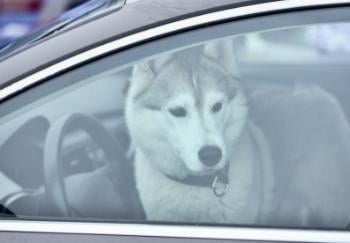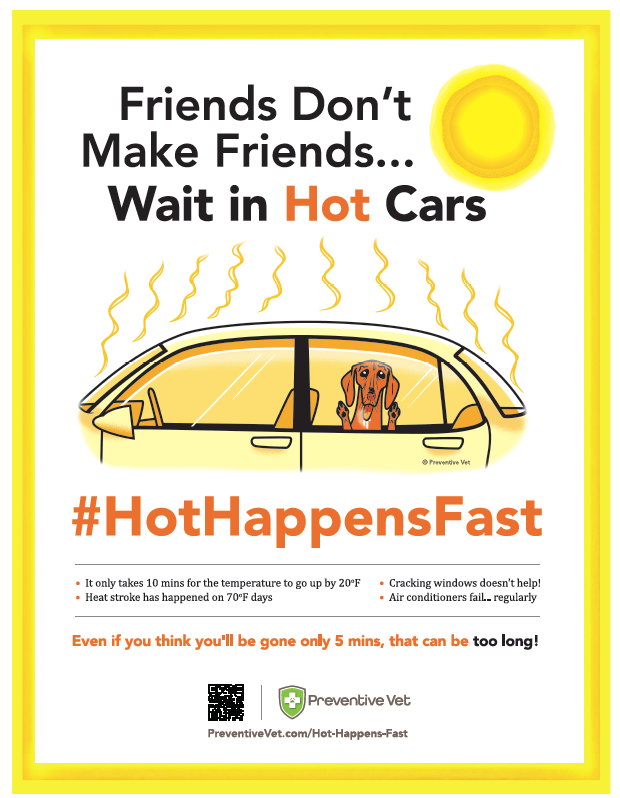
Sadly, there are still many erroneous myths and misconceptions out there surrounding the idea that it’s ok to leave pets unattended in parked cars.
These dangerous practices contribute to the many heatstroke cases and deaths that my colleagues and I see and treat daily during the warmer months as well as those stories that circulate in the news and online all too frequently.
You may also be wondering what you should do (and legally can do) if you see a dog in a parked car on a warm day. Is it legal to break a car window to save a dog? What are the signs that a dog is overheating in a car?
Let’s look at the misconceptions around leaving dogs in cars and what your options are if you see a dog overheating in one.
Skip to Section:
5 Misconceptions About Leaving Dogs in CarsIs It Legal to Break a Car Window to Save a Dog?
What to Do Before Breaking a Window to Save a Dog
Spread the Word: How You Can Help Raise Awareness
The more people we can get to recognize the inherent dangers of these misconceptions and practices, the more illnesses, injuries, and deaths from heatstroke we can all help to prevent. Share this article to help spread education and to help protect pets everywhere!
5 Misconceptions About Leaving Dogs in Parked Cars
#1: “Leaving the windows cracked or open all the way makes a difference.”
The Reality: Multiple studies have shown that leaving the windows cracked makes little to no difference to the inside temperature of a vehicle and has an overall insignificant protective benefit.
- According to one study, the temperature inside of a closed car rises 3.4°F every 5 minutes. “Cracking the window” only brought down the temperature increase to 3.1°F every 5 minutes. Not a whole lot of difference!
In total, there was approximately a 40°F total heat increase inside the car over 60 minutes with the windows completely closed, compared to a 37.2°F rise with windows ‘cracked.’ Which, on a 90-degree day, equals 127.2 degrees! Even on a cooler day of 72°F, the temperature reached 117°F. Under either scenario, that’s extremely hot, EXTREMELY detrimental to your dog’s health, and potentially fatal. - Another study showed within 15 minutes, a closed vehicle reached 152.6°F. As a comparison, the windows of the car were cracked about 2 inches, and the car still reached a staggering temperature of 122°F.
- The American Veterinary Medical Association cites a study showing that cracking the window of a car has very little effect on the temperature increase inside the car. They feature a helpful chart showing the temperature outside versus inside the car over elapsed time on a hot but partly cloudy day.
- The Davis Weather Station in Mississippi conducted their own experiment comparing the temperature of a car with closed windows to that with the windows ‘cracked.’ What they found was that after 30 minutes, the temperature in the car with the windows closed reached 126°F and 124°Fwith the windows ‘cracked.’ Not much of a difference!
As you can see, while cracking the windows may have a slight effect on decreasing the temperature on the inside of the car, that effect is minimal, and it is not enough to prevent the temperature inside a car from quickly rising to dangerous or deadly levels.
But what cracking windows WILL do will make you feel better about leaving your pet in a hot car which you should now recognize doesn’t make a difference.
All in all, cracked widows aren’t all they’re ‘cracked’ up to be. If you’re taking your dog shopping, take a second person with you that can sit with your dog or take them for a walk; otherwise, leave Fido at home.

Tips about Pets in Cars:
- Do not leave your pets or kids alone in parked cars.
- Cracking windows, short periods of time, relatively mild days, leaving water, or running the air conditioner does not make a parked car a safe place for a pet to be alone.
- Help spread awareness. Download the #HotHappensFast poster
#2: “I’ll only be gone for a few minutes”
The Reality: Whenever you run into a store, there are plenty of factors that are outside of your control which can prolong your time away from your dog, who is locked inside your car that is getting hotter and hotter the longer you stay away.
Consider a longer-than-usual check-out line, bumping into a friend or neighbor, forgetting something from your shopping list, or even a slip and fall. There really are many unforeseen things that could realistically and significantly delay your return to your car. And that delay can result in your dog suffering (and potentially dying) from heatstroke.
The next time you dart into a store for a “quick shopping trip,” time yourself. Do this exercise a few times and see how long “a few minutes” can actually be. Then keep the following numbers in mind:
- 19° – that’s the average °F temperature rise in a parked after just 10 minutes in one study
- 29° – the average °F temp rise after just 20 minutes
- 34° – the average °F temp rise after 30 minutes
- 43° – the average °F temp rise after 60 minutes
Now imagine what this would equate to on a relatively mild 80°F day. Imagine what it would be on one of the 100°F days that are common in certain areas and are becoming more commonplace in others. The results can be devastating – quickly!
#3: “It’s only 70°F out; there’s no danger of heatstroke for my dog.”
The Reality: Temperatures in the low 70s are more than hot enough to cause a dog left in a parked car to develop and suffer from heatstroke. In fact, the study cited above was conducted in San Francisco on a series of relatively mild days. On one of the 72°F days during the study, the temperature inside the test car reached 93°F in 10 minutes, 105°F in 20 minutes, 110°F in 30 minutes, and 119°F in 60 minutes! At these temperatures, symptoms of heatstroke are not only likely to happen but are almost guaranteed.
Not only is 70°F warm enough to result in heatstroke, but even temperatures in the low 60s can also be dangerous for some pets. This is because certain cats and dogs – based on factors such as breed, weight, existing medical conditions, and several other factors – are actually more sensitive to heat than others and, therefore, at even greater risk of developing and suffering from heatstroke. You can learn more about these predisposing factors in our Heat Stroke in Dogs and Cats article.
#4: “I always leave water in the car for my dog, so I don’t have to worry about heatstroke.”
The Reality: Although having water available for your pet at all times is always appropriate when it comes to leaving your dog in a locked car, leaving water for them will help to prevent dehydration and heat exhaustion, it does very little to stave off heatstroke when temperatures start to soar.
The reason for this is that dogs rely mostly on the evaporative cooling effects of panting to get rid of excess heat. Dogs are unable to sweat like people, and their ability to cool down is quickly overwhelmed in a hot, stuffy car with little to no fresh air circulation. This is regardless of whether they have a water bowl in front of them.
 #5: “I leave the air conditioner running, so I don’t have to worry about heatstroke.”
#5: “I leave the air conditioner running, so I don’t have to worry about heatstroke.”
The Reality: Air conditioner compressors and car engines fail, and dogs knock into and inadvertently press and hit buttons and switches. Sadly, there are plenty of cases of dogs dying when the car air conditioner fails, or a dog bumped into and switched off the air conditioner.
When air conditioner compressors fail, the air blowing into the car from the vents often turns from cool to hot, greatly speeding up the temperature rise within the car.
So, while leaving your car air conditioner running can help to protect your dog from heatstroke, it can also provide a false sense of security, and it can even backfire.
Is it Legal to Remove a Dog from a Hot Car?
Now for the more difficult questions because it’s tough to provide a 100% conclusive, clear-cut answer regarding the issue of legality. It’s not that I don’t want to — believe me, I do! — but the law is often ambiguous and subject to interpretation. Furthermore, the rules about rescuing dogs from hot cars vary from state to state (even city to city, in some instances). And unfortunately, unlike some other good Samaritan rescue operations, getting someone else’s dog out of a dangerously hot car is one of the few instances when your heroics could actually make you vulnerable to legal troubles (or even a physical altercation).
Now, that being said, there is some good news. A number of state legislatures have passed laws (or are in the process of doing so) that protect good Samaritans who, in good faith and in an appropriate manner, enter a hot car to rescue a dog from harm or even death. And more and more states are following suit.
 How State Rules Differ About Rescuing Dogs From Hot Cars
How State Rules Differ About Rescuing Dogs From Hot Cars
In states like Arizona and California, ordinary citizens are granted legal immunity if they damage someone’s vehicle to rescue “an animal.” While other states, like Illinois, don’t have “good Samaritan” laws that protect ordinary citizens who rescue animals that are trapped in hot cars, they do have provisions that protect law enforcement and other official first responders (like animal control officers) from civil liability. And in Indiana, a good Samaritan is partially protected but still legally required to pay half the cost for property damage.
Does this mean that you could or should run around, willy-nilly, smashing car windows with rocks if you live in a state that grants you legal immunity? Of course not. But it does mean that, in these states, you could do so without fear of prosecution in certain situations and after taking certain precautions and following certain steps.
Am I Liable for Rescuing a Dog from a Hot Car in My State?
The table below outlines the basic laws for each state. It is up-to-date as of July 6th, 2021, and is based on information compiled by the Animal Legal Defense Fund’s Overview of State Laws: Leaving Unattended Animals in Vehicles and Michigan State University College of Law’s State Laws that Protect Animals Left in Parked Vehicles pages (which are great resources!).
Of course, laws change, so use this information as a general guide and double-check with the legal resources linked above.
To best educate yourself, look up your state’s laws specifically — they’re often in the Motor Vehicle Code. The drop-down table below will show whether your state has any of the three types of laws surrounding unattended animals in vehicles:
- Laws against leaving animals in a car in a way that puts them at risk
- Law that allows public officials (police officers, firefighters, etc.) to enter a locked vehicle to rescue an animal in distress
- “Good Samaritan” laws that allow a private citizen to enter a locked vehicle to rescue an animal in distress after proper steps have been taken
Please note that even with Good Samaritan laws, there may still be some liability associated with entering someone else’s locked vehicle to save an animal.
Disclaimer: The following information is meant to provide an overview of state laws. Check the law in your state to determine the specific level of liability, even if a good Samaritan law is on the books.
If your state doesn’t have such laws, reach out directly to your state representatives and ask them to introduce a Good Samaritan bill to help protect animals and those who would take steps to look out for their safety.
Things to Do BEFORE Breaking a Window to Save a Dog
Call 911 FIRST! There is ALWAYS time to call 911 to see if they are already aware of the situation and if they have a first responder on the way and to obtain their advice BEFORE you take the law into your own hands.
Also, bookmark our Hot Happens Fast resource page in case you ever need it: there's a detailed list of what to do and what not to do, as well as how to care for a pet once they are out of the vehicle. #HotHappensFast
Check for Signs of Imminent Danger
Scenario 1: If the dog is unresponsive, has collapsed, is staggering, or appears mentally disoriented, it is very likely the dog is in imminent danger of death, and immediate action is necessary if there is any hope of survival for the animal.
Scenario 2: However, if you notice the dog is panting, pacing, or scratching at the doors/windows and otherwise appears mentally alert, there is likely time — perhaps not much time, but some time — to handle things in a way that assists removing the dog safely from the vehicle and ensures that the correct person winds up facing charges.
For example, a Preventive Vet team member noticed a dog in this video in a parking garage at the Portland REI on an 86-degree day. The employees at REI were excellent and quickly helped to locate the owner and help save this dog.
Gather Information & Search for the Owner
- Document everything! Having physical evidence of the scenario is extremely important to ensure that charges are laid on the correct person and that, if necessary, the animal is not returned if they were in an unsafe situation.
Nowadays, almost every person has some form of a smartphone with a built-in camera and video capabilities. So even if you don't have a phone on you, the odds are that another person close by does. Photos and short videos aren't just excellent evidence should the legal system ever need to get involved, but they can also prove highly valuable when trying to convince nearby store employees to make the overhead announcements that can help find and alert the owner of their pet in distress, hopefully expediting the rescue of the pet. - Make note of the time. In all situations, noting the time at which you first came upon the dog in the car can help to provide vitally important information should the law ever get involved and if the veterinarian needs documentation for medical reasons. If you can provide proof, even better. Pet owners will often come back to the car insisting they were only gone 5 minutes when it was actually 20. Timing it with a phone call or text message to a friend is a great form of proof.
- Make note of the location. This information will be useful when trying to find the owner of the car and dog, which should be attempted prior to breaking a window.
- Note the details about the vehicle and the pet(s) inside. Again, this information is important in attempting to locate the owner. Things like the color and make of the car, as well as the license plate number, the more details, the better.
- Recruit helpers and witnesses. Since there may be many stores or other nearby places of business where the owner of the car may be, it's helpful to have many people involved in the search. This group of people will also prove valuable should action need to be taken to help the heat-distressed pet, as well as to document and provide supportive testimony should the case wind up being judged by the legal system.
For a list of the things you should and shouldn't do when administering first aid to a dog suffering from heat-related illness, please see the How To Treat Heat Stroke.
Steps I DO NOT Recommend:
- Breaking into a vehicle: The legality of breaking into a vehicle to save an overheating dog depends on your local laws and whether you've completed important steps prior to entering the vehicle. If the situation is clearly dire, as in a person’s or animal’s life is in imminent danger, you’ve got to do what you’ve got to do and hope that the law will look favorably upon your actions (even though the owner of the pet and the vehicle may not – although even they actually might). I am in no way encouraging or recommending such actions; you do so at your own risk. Again, get familiar with the local and state laws where you live.
- Reaching through a cracked window: Regardless of how good your intentions are, putting your hand through a cracked window to give an overheated dog water or unlock a car door is not without its risks. The dog may bite you or even bolt out of the car only to risk injury from passing traffic.
That said, if you can safely provide water, without sticking your hand into the car, to a dog confined in such a situation, then by all means, do so. And if the dog is in imminent danger of death from heatstroke and the window is cracked, that may well be the easiest and safest way to gain entry to the car to help the dog — rather than breaking a window (Disclaimer: See caution about “Breaking into a vehicle” above – this action may be illegal, and you do this at your own risk). - Getting into an altercation: As upset and angry as you may be by the actions of the person or people who have left their pet in this dangerous situation, it doesn’t do anybody any good to verbally or physically assault them upon their return to their vehicle. Not only will it make them defensive and decrease the likelihood that they’ll be receptive to your message about the dangers of leaving pets in hot cars, but it may even lead to injury and/or criminal charges. None of which is helpful to the cause. Just stick with the facts and try to remain calm. This is yet another reason to recruit others and to contact the appropriate authorities when the situation requires it.
Awareness & Public Education: How You Can Help
Advocating for awareness is another excellent way to help decrease the instances of pets being left in hot cars.
- Encourage your local businesses to put up educational and warning signs in their parking lots and stores. This sign was outside the front door at MudBay in Seattle. Job well done!

- If you're a store owner or administrator, consider deploying a patrol in your parking lots as this one did! Or have staff ask when patrons walk in. Share posts on social media. Remind friends with pets. There is no such thing as too much information, especially when it comes to saving a life.
- Share this graphic. The more people that are aware of the dangers and who are vigilantly monitoring the actions of those who aren't, the better the situation will become... and the more pets will be saved from these heartbreaking tragedies. Here's a link to easily share this graphic on Facebook, and here's one for Twitter.





